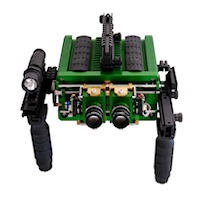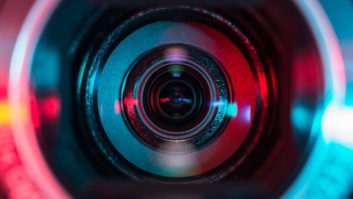
The Meduza 4K stereo camera will be presented at IBC with a range of four cameraheads, three sensors and three back-end distribution systems to be selected as applicable. It will also feature over 2000 accessories built, it says to NATO’s military specification. The rental price of the camera including body, head and tech support for one year has been set at $27,500. Designer Jonathan Kitzen claims to have pioneered the single sensor dual lens system used on the Phantom Zepar 65-Z3D. The modular design of the Meduza means that developer Meduza Systems will be able to exchange critical parts of the camera for the latest technologies as they become available. This includes the sensor, two of which will be included onboard and for which Meduza so far has signed three partners – Aptina, Omnivision with one undisclosed. Sensor as film stock According to Chris Cary, CEO of parent company 3D Visual Enterprises, “We think of the sensor as like film stock in which DPs would choose the appropriate size, sensitivity and resolution of imager appropriate for each project. Each sensor has different qualities, rendering or colour characteristics or formats and are useful for different jobs. Most DPs haven’t been thinking in terms of sensors this way. We may be the first company to do this but we won’t be the last.” A DP Cary explains will choose the front sensor module (head), sensor and back-end to the Meduza’s body depending on the job in hand. “The body is the brain of the camera and will have the intelligence to recognise what head, sensor and back are attached to the camera and what the characteristics are of each,” says Cary. “We are offering the camera in whatever configuration the user needs, so it can be set up in HD and swapped to 4K in 60 seconds. Shooting in +4k in 4:3, we hope will be liberating for the giant screen production community where for the first time the camera can access places and perspectives that cumbersome equipment has made impossible.” Unlike any other camera system there is no ‘fixed’ specification, he says. “The Meduza is customisable so that you can easily convert it to specific purpose. That might be changing the sensors to lowlight near IR for night time wildlife, security or military applications, or going for higher speed frame rates for sports. You could shoot at 400fps for sports or for IMAX at 170fps. Change the camera to do what it needs to.” Indeed the company claims Meduza is the first camera ever to be built around the NATO accessory specification and can be fitted with over 2000 different existing accessories from grips, rods, shoulder stocks and straps to tripods, bi-pods, lights, and rangefinders. Even its website is dressed in military camo with pictures which wouldn’t look out of place in a gun magazine.
Iridas support Meduza has worked with Iridas to support output of CinemaDNG files but Cary says the camera can be programmed to support many other output formats. A 4TB data pack will be offered as one back end module, another will be applicable to live production and offer HDMI. “We have been working with Iridas and others and the camera does not output its own codec,” explains Meduza Systems president Jonathan Kitzen. “Rather we have adopted .DNG which is accepted by just about every major platform, and with some of the other companies we are in discussion with you should be able to output to multiple standards with the release camera. By avoiding creating yet another proprietary format we avoid post production conflicts.” Ownership of the system is likely to be split between rental and sale. The body will effectively be leased long term because, says Cary, of the need to constantly update software tuned to new lens configurations, some of which can be done as firmware upgrades online. The head and backs will likely be available to rent or purchase. A figure of $27,500 has been put on a year’s rental including head/back/body and full technical support. Meduza will offer its own matched optics for the 2/3″ and under sensor formats. These optics have been rebuilt from Schneider glass to the company’s own specifications. “Schneider makes some wonderful glass, but to get it to complete match at the very high resolutions required for 4K we have had to redesign the entire lens. These will also deliver with the first cameras in the summer as a set of six matched primes. The next generation will be all custom glass for the beyond 4K series.” Meduza will feature full inter-axial and convergence control on the head as well as iris and focus. “The Sony and Panasonic [integrated 3D] cameras only have full iris and focus control,” claims Cary. “Control of IA and convergence really is the tool that the filmmaker needs to have and was a pre-requisite from the beginning.” Sony’s PMW-TD300 (3D shoulder cam) does indeed have fixedIA control with full convergence control (via a dial on the side of the camera) and its 3D NXCAM hasfixed IA and convergence. Panasonic’s AG-3DA1 and P1, according to the manufactureroffer convergence control but only fixed IA. Range of heads Meduza will have a range of heads that provide different characteristics and configurations. The normal production version of one of the heads will have two lenses side by side capable of delivering IA of 38-100mm.“However, if someone needed to have less that 38mm we will have a different configuration on the head that allows the lenses to move between 65 and 0mm,” says Cary. This small module or mirror rig will replace the head, is interchangeable with the standard accessories and designed not to exceed the dimensions of the unit when used with the 2/3rd inch lenses. “A better way of thinking about it is that it is the same exact module as the variable IA module but one linear drive motor is flipped to work with the mirror,” says Kitzen. “It is less than the 200mm wide width of the camera.” Trials have taken in cycling, swimming and surfing events while the prototype was used to shoot this year’s Pamplona bull run for an IMAX feature film being produced by Cary.
Meduza on IMAXIt was during early shoots on the film in Pamplona in 2009 using IMAX 3D rigs that the idea for Meduza was born. “Two motorcycles glued together don’t make a car,” says Cary, a former worldwide sales chief at Lumiere Pictures with a background in the music industry and live events production. “We aren’t the only ones who know that but while everyone is trying to work in the confines of a rigged system, we are doing something that if you think about it is perfectly logical. Red Digital took a step ahead of the pack but the pack has now caught up.” He continues: “Technology is moving so fast that however we built a camera it would be obsolete before it came out so it has to be modular so it will never go out of date and then our relationship with customers is perpetual. We’re not putting two cameras inside of one body with two clocks and two of everything, each with its own life. We had to get rid of the ‘twoness’ of it so that there is on clock, one optical brain.” Although it needs more work, the idea is to accommodate the nodal point (the point where the light rays converge in the lens), the most accurate representation of what the eye sees, and therefore bypass the uncomfortable eye-strains experienced by some 3D viewing. “By rotating around this axis (like your eyes do) you minimize distortion and perspective changes,” adds Kitzen. “However every lens has a different nodal point so it’s not simple.” Kitzen himself was introduced to 3D in 1993 when working in Russia developing and exporting cameras and optics outside the newly open Russian Federation. “In 2009 I pioneered the single sensor dual lens system used on the Phantom 65 that was developed in Russia and which we proved was viable.” See here for more: http://www.tvbeurope.com/newsletter-3dmasters-content/full/trumbull-backs-phantom-zepar “While I have 3D experience I don’t think it’s critical at all to building a good 3D camera. There are plenty of well made systems that have emerged from companies with no past 3D history, and plenty of badly designed ones that come from founders with extensive 3D experience.”
www.meduzasales.comThe Meduza 4K stereo camera will be presented at IBC with a range of four cameraheads, three sensors and three back-end distribution systems to be selected as applicable. It will also feature over 2000 accessories built, it says to NATO’s military specification. The rental price of the camera including body, head and tech support for one year has been set at $27,500. Designer Jonathan Kitzen claims to have pioneered the single sensor dual lens system used on the Phantom Zepar 65-Z3D. The modular design of the Meduza means that developer Meduza Systems will be able to exchange critical parts of the camera for the latest technologies as they become available. This includes the sensor, two of which will be included onboard and for which Meduza so far has signed three partners – Aptina, Omnivision with one undisclosed. Sensor as film stock According to Chris Cary, CEO of parent company 3D Visual Enterprises, “We think of the sensor as like film stock in which DPs would choose the appropriate size, sensitivity and resolution of imager appropriate for each project. Each sensor has different qualities, rendering or colour characteristics or formats and are useful for different jobs. Most DPs haven’t been thinking in terms of sensors this way. We may be the first company to do this but we won’t be the last.” A DP Cary explains will choose the front sensor module (head), sensor and back-end to the Meduza’s body depending on the job in hand. “The body is the brain of the camera and will have the intelligence to recognise what head, sensor and back are attached to the camera and what the characteristics are of each,” says Cary. “We are offering the camera in whatever configuration the user needs, so it can be set up in HD and swapped to 4K in 60 seconds. Shooting in +4k in 4:3, we hope will be liberating for the giant screen production community where for the first time the camera can access places and perspectives that cumbersome equipment has made impossible.” Unlike any other camera system there is no ‘fixed’ specification, he says. “The Meduza is customisable so that you can easily convert it to specific purpose. That might be changing the sensors to lowlight near IR for night time wildlife, security or military applications, or going for higher speed frame rates for sports. You could shoot at 400fps for sports or for IMAX at 170fps. Change the camera to do what it needs to.” Indeed the company claims Meduza is the first camera ever to be built around the NATO accessory specification and can be fitted with over 2000 different existing accessories from grips, rods, shoulder stocks and straps to tripods, bi-pods, lights, and rangefinders. Even its website is dressed in military camo with pictures which wouldn’t look out of place in a gun magazine.
Iridas support Meduza has worked with Iridas to support output of CinemaDNG files but Cary says the camera can be programmed to support many other output formats. A 4TB data pack will be offered as one back end module, another will be applicable to live production and offer HDMI. “We have been working with Iridas and others and the camera does not output its own codec,” explains Meduza Systems president Jonathan Kitzen. “Rather we have adopted .DNG which is accepted by just about every major platform, and with some of the other companies we are in discussion with you should be able to output to multiple standards with the release camera. By avoiding creating yet another proprietary format we avoid post production conflicts.” Ownership of the system is likely to be split between rental and sale. The body will effectively be leased long term because, says Cary, of the need to constantly update software tuned to new lens configurations, some of which can be done as firmware upgrades online. The head and backs will likely be available to rent or purchase. A figure of $27,500 has been put on a year’s rental including head/back/body and full technical support. Meduza will offer its own matched optics for the 2/3″ and under sensor formats. These optics have been rebuilt from Schneider glass to the company’s own specifications. “Schneider makes some wonderful glass, but to get it to complete match at the very high resolutions required for 4K we have had to redesign the entire lens. These will also deliver with the first cameras in the summer as a set of six matched primes. The next generation will be all custom glass for the beyond 4K series.” Meduza will feature full inter-axial and convergence control on the head as well as iris and focus. “The Sony and Panasonic [integrated 3D] cameras only have full iris and focus control,” claims Cary. “Control of IA and convergence really is the tool that the filmmaker needs to have and was a pre-requisite from the beginning.” Sony’s PMW-TD300 (3D shoulder cam) does indeed have fixedIA control with full convergence control (via a dial on the side of the camera) and its 3D NXCAM hasfixed IA and convergence. Panasonic’s AG-3DA1 and P1, according to the manufactureroffer convergence control but only fixed IA. Range of heads Meduza will have a range of heads that provide different characteristics and configurations. The normal production version of one of the heads will have two lenses side by side capable of delivering IA of 38-100mm.“However, if someone needed to have less that 38mm we will have a different configuration on the head that allows the lenses to move between 65 and 0mm,” says Cary. This small module or mirror rig will replace the head, is interchangeable with the standard accessories and designed not to exceed the dimensions of the unit when used with the 2/3rd inch lenses. “A better way of thinking about it is that it is the same exact module as the variable IA module but one linear drive motor is flipped to work with the mirror,” says Kitzen. “It is less than the 200mm wide width of the camera.” Trials have taken in cycling, swimming and surfing events while the prototype was used to shoot this year’s Pamplona bull run for an IMAX feature film being produced by Cary.
Meduza on IMAXIt was during early shoots on the film in Pamplona in 2009 using IMAX 3D rigs that the idea for Meduza was born. “Two motorcycles glued together don’t make a car,” says Cary, a former worldwide sales chief at Lumiere Pictures with a background in the music industry and live events production. “We aren’t the only ones who know that but while everyone is trying to work in the confines of a rigged system, we are doing something that if you think about it is perfectly logical. Red Digital took a step ahead of the pack but the pack has now caught up.” He continues: “Technology is moving so fast that however we built a camera it would be obsolete before it came out so it has to be modular so it will never go out of date and then our relationship with customers is perpetual. We’re not putting two cameras inside of one body with two clocks and two of everything, each with its own life. We had to get rid of the ‘twoness’ of it so that there is on clock, one optical brain.” Although it needs more work, the idea is to accommodate the nodal point (the point where the light rays converge in the lens), the most accurate representation of what the eye sees, and therefore bypass the uncomfortable eye-strains experienced by some 3D viewing. “By rotating around this axis (like your eyes do) you minimize distortion and perspective changes,” adds Kitzen. “However every lens has a different nodal point so it’s not simple.” Kitzen himself was introduced to 3D in 1993 when working in Russia developing and exporting cameras and optics outside the newly open Russian Federation. “In 2009 I pioneered the single sensor dual lens system used on the Phantom 65 that was developed in Russia and which we proved was viable.” See here for more: http://www.tvbeurope.com/newsletter-3dmasters-content/full/trumbull-backs-phantom-zepar “While I have 3D experience I don’t think it’s critical at all to building a good 3D camera. There are plenty of well made systems that have emerged from companies with no past 3D history, and plenty of badly designed ones that come from founders with extensive 3D experience.”







